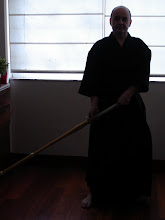We concentrated on men-uchi last week. We started by hitting men from a static position then progressed through taking just one sliding step, to stepping into distance and striking, through to hitting with fumikomi ashi and then moving into zanshin. We finished with debana men practice during which a dojo member asked for my advice on why he was having difficulty pushing off to make the strike. Instead of being able to launch an attack at will, all of his weight was moving to the left foot and he needed to readjust his foot position before he could move.
Watching his practice it was obvious that the heel of his left foot was too far off the ground, to the extent that he had no traction to push himself forward. Instead he had to move his left foot forward each time that he needed to attack. To my mind a lot of energy was being wasted on unnecessary action.
 Matsumoto Toshio sensei talked about the sole of the left foot being at a 15% angle from the floor, with the left leg being almost straight and keeping a feeling of tension behind the left knee. If you follow this advice then it is possible to move instantly from any spot. You of course need to keep the distance between your feet constant throughout your keiko, moving the left foot into position whenever your right foot moves, but you should be able to stop at any given time and instantly launch from the back foot.
Matsumoto Toshio sensei talked about the sole of the left foot being at a 15% angle from the floor, with the left leg being almost straight and keeping a feeling of tension behind the left knee. If you follow this advice then it is possible to move instantly from any spot. You of course need to keep the distance between your feet constant throughout your keiko, moving the left foot into position whenever your right foot moves, but you should be able to stop at any given time and instantly launch from the back foot.
How far apart your feet should be is open to debate. Conventional kendo wisdom suggests that the big toe of the left foot should be in line with the heel of your right foot and that there should be a fist’s distance separating the width of your stance. In reality some All Japan class players have a much bigger gap between the forward and rear foot and they have the leg strength to make much longer steps than us amateurs. I also believe that the fists distance in width is only a guide. In most sports, feet and knees should be in line with your hips. So your feet should be far enough apart for you to be stable and balanced.
The final piece of the jigsaw is to ensure that as you push with the left the right foot moves forward and not up. By keeping a slight bend in your right knee you should be able to make fumikomi with a big slapping sound and not damaging you knee or heel in the process.




No hay comentarios:
Publicar un comentario